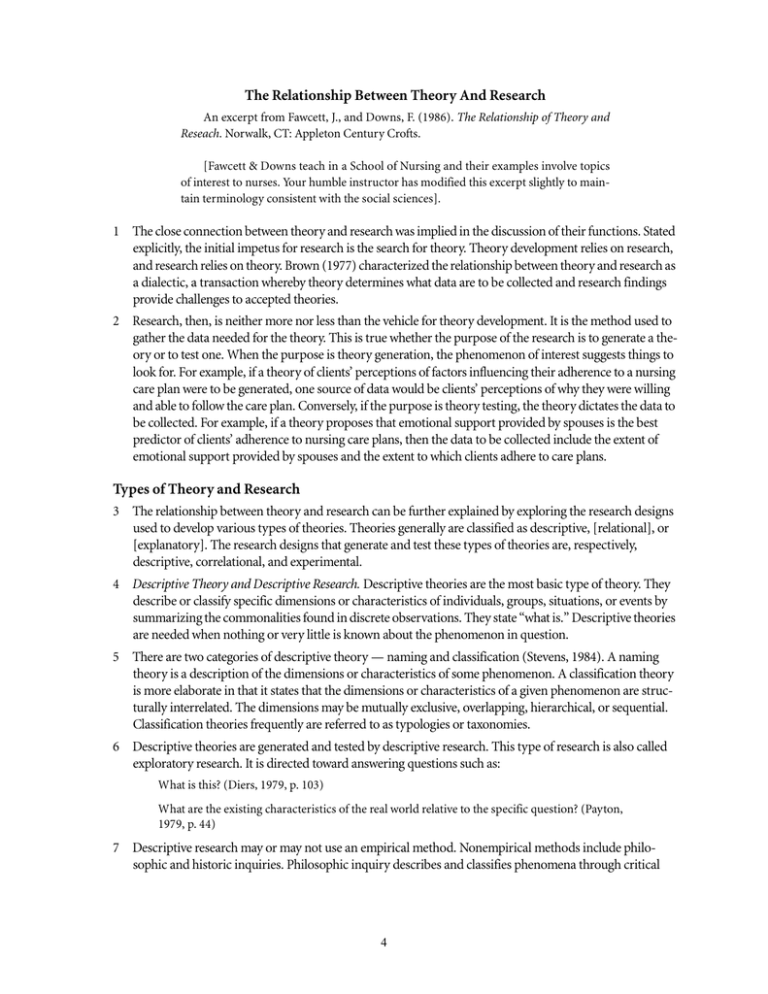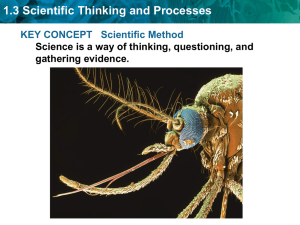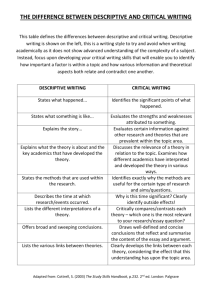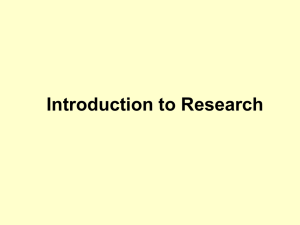The Relationship Between Theory And Research Types of Theory
advertisement

The Relationship Between Theory And Research An excerpt from Fawcett, J., and Downs, F. (1986). The Relationship of Theory and Reseach. Norwalk, CT: Appleton Century Crofts. [Fawcett & Downs teach in a School of Nursing and their examples involve topics of interest to nurses. Your humble instructor has modified this excerpt slightly to maintain terminology consistent with the social sciences]. 1 The close connection between theory and research was implied in the discussion of their functions. Stated explicitly, the initial impetus for research is the search for theory. Theory development relies on research, and research relies on theory. Brown (1977) characterized the relationship between theory and research as a dialectic, a transaction whereby theory determines what data are to be collected and research findings provide challenges to accepted theories. 2 Research, then, is neither more nor less than the vehicle for theory development. It is the method used to gather the data needed for the theory. This is true whether the purpose of the research is to generate a theory or to test one. When the purpose is theory generation, the phenomenon of interest suggests things to look for. For example, if a theory of clients perceptions of factors influencing their adherence to a nursing care plan were to be generated, one source of data would be clients perceptions of why they were willing and able to follow the care plan. Conversely, if the purpose is theory testing, the theory dictates the data to be collected. For example, if a theory proposes that emotional support provided by spouses is the best predictor of clients adherence to nursing care plans, then the data to be collected include the extent of emotional support provided by spouses and the extent to which clients adhere to care plans. Types of Theory and Research 3 The relationship between theory and research can be further explained by exploring the research designs used to develop various types of theories. Theories generally are classified as descriptive, [relational], or [explanatory]. The research designs that generate and test these types of theories are, respectively, descriptive, correlational, and experimental. 4 Descriptive Theory and Descriptive Research. Descriptive theories are the most basic type of theory. They describe or classify specific dimensions or characteristics of individuals, groups, situations, or events by summarizing the commonalities found in discrete observations. They state what is. Descriptive theories are needed when nothing or very little is known about the phenomenon in question. 5 There are two categories of descriptive theory naming and classification (Stevens, 1984). A naming theory is a description of the dimensions or characteristics of some phenomenon. A classification theory is more elaborate in that it states that the dimensions or characteristics of a given phenomenon are structurally interrelated. The dimensions may be mutually exclusive, overlapping, hierarchical, or sequential. Classification theories frequently are referred to as typologies or taxonomies. 6 Descriptive theories are generated and tested by descriptive research. This type of research is also called exploratory research. It is directed toward answering questions such as: What is this? (Diers, 1979, p. 103) What are the existing characteristics of the real world relative to the specific question? (Payton, 1979, p. 44) 7 Descriptive research may or may not use an empirical method. Nonempirical methods include philosophic and historic inquiries. Philosophic inquiry describes and classifies phenomena through critical discussion. Smith (1983), for example, used the method of philosophic inquiry to clarify the idea of health. In doing so, she developed a typo!ogy of various conceptions of health held by people. 8 Historic research is, of course, directed toward the description of phenomena that occurred at an earlier time. For example, Baer (1985) examined the nature and scope of the divisions in American nursing in the last third of the nineteenth century through a description of the conflicting schemes for organizing nursing in hospitals proposed by Florence Nightingale, Linda Richards, and Isabel Hampton. 9 Descriptive studies employing the empirical method involve observation of a phenomenon in its natural setting. Data are gathered by participant or nonparticipant observation, as well as by open-ended or structured interview schedules or questionnaires. The raw data gathered in a descriptive study may be qualitative and/or quantitative. Qualitative data may be analyzed by means of content analysis. This technique is used to sort data into a priori categories or into categories that emerge during the analysis. Quantitative data are analyzed by various nonparametric or parametric measures of central tendency and variability. 10 Empirical descriptive research encompasses case studies, surveys, grounded theory, ethnographies, and phenomenologic studies. Case studies are intensive and systematic investigations of many factors for a small number of individuals, a group, or a community. Durand (1975), for example, used the case study approach to describe the impact of an intensive nursing care program for a five-year-old boy with Downs syndrome and severe failure to thrive. Surveys yield factual and accurate descriptions of an intact phenomenon. Typically, surveys use structured instruments for data collection, although open-ended questions may be included in the instrument. An example is the research of Medoff, Cooper and Schraeder (1982), who conducted a survey of very low birth weight infants in order to describe their developmental status and temperament. 11 The method of grounded theory yields a description of processes occurring in social situations. Every piece of data is constantly compared with every other piece in order to discover the dominant social processes that characterize the phenomenon under study. An example of this method is Stern's study (1978), which generated a theory of the process of discipline used by stepfathers. Ethnography yields a theory of cultural behavior for a particular society or societal group. Emphasis is placed on describing the group's way of life, from the perspectives of the group members. For example, Germain (1982) conducted an ethnography of an adult oncology unit in a community hospital in order to describe the various roles nurses played, the problems and stresses they faced, their ways of trying to cope with these problems, and the consequences of their behaviors. The method of phenomenology yields a description of human experiences. The investigator gathers data without preconceived expectations or a priori definitions of terms. Emphasis is placed on understanding individuals cognitive, subjective perceptions and the effect of those perceptions on behavior. Paige (1980), for example, used a phenomenologic approach to develop a descriptive theory of the meaning of death held by individuals who knew they would die in the near future. 12 [Relational] Theory and Correlational Research. [Relational] theories specify relations between dimensions or characteristics of individuals, groups, situations, or events. They explain how the parts of a phenomenon are related to one another. These theories can be developed only after the essential characteristics of a phenomenon are known, that is, only after descriptive theories have been developed and validated. 13 [Relational] theories are developed by correlational research. This type of research seeks to answer such questions as: What's happening here? (Diers, 1979, p. 125) To what extent do two (or more) characteristics tend to occur together? (Payton, 1979, p. 44) 14 Correlational studies use the empirical method. They require measurement of the dimensions or characteristics of phenomena in their natural states. Interviews and surveys are two frequently used approaches. Data usually are gathered by nonparticipant observation or self-report measures. In contrast to descriptive research, instruments usually are fixed-choice observation checklists, rating scales, or standardized questionnaires. This is possible because the dimensions or characteristics of the phenomenon are believed to be known. These instruments yield qualitative or quantitative data. Because numbers must be attached to the raw data so that correlation coefficients can be calculated, qualitative data must be categorized, and numbers must be assigned to the categories. Statistical analyses of the data employ various nonparametric or parametric measures of association. 15 Munro's study (1983) is an example of correlational research. She tested the Herzberg Motivation Hygiene Theory in her investigation of correlates of job satisfaction among recent graduates of nursing programs. Another example is ORourke's study (1983), which developed a theory addressing the relationships among self-reports of somatic, affective, and behavioral symptoms and of current health status; demographic characteristics; and subjective appraisal of psychological well-being. 16 [Explanatory]Theory and Experimental Research. [Explanatory] theories move beyond [relational statements] to the prediction of precise [causative] relationships between dimensions or characteristics of a phenomenon or differences between groups. This type of theory addresses cause and effect, the why of changes in a phenomenon. [Explanatory] theories may be developed after [relational] theories have been formulated. 17 [Explanatory] theories are generated and tested by experimental research. This type of research asks questions such as: What will happen if. . . ? (Diers, 1979, p. 145) Is treatment A different from treatment B? (Payton, 1979, p. 45) 18 Experimental research employs the empirical method of experimentation. This method involves the manipulation of some phenomenon to determine its effect on some dimension or characteristic of another phenomenon. Experimentation encompasses many different designs, including preexperiments such as the pretest-posttest-no control group design; quasi-experiments such as the nonequivalent pretest- posttest-control group design and time series analysis; and true experiments such as the Solomon Four Group and the posttest only designs. 19 Like correlational research, experimental research requires quantifiable data. This is because numbers are needed to determine if an experimental treatment makes a difference, and if so, how much of a difference. [Actually, the numbers are needed because of the inferential mechanism]. Typically, these data are collected by standardized research instruments with calibrated scores. Parametric statistical techniques, such as analysis of variance, are most frequently used to analyze the data. 20 Experimental nursing research includes the many studies of the effects of various types of information given prior to a medical or surgical procedure on postprocedure outcomes. Ziemer (1983), for example, conducted an experiment to determine the effects of procedural, sensory, and coping strategies information on postoperative coping behaviors. This study was designed to test a refinement of the theory of cognitive imagery developed by Johnson and associates (1978). Distinctions Among Types of Research 21 The distinctions among types of research are not always as clear-cut as they are outlined in this chapter. For example, although most authors classify any study that involves manipulation of a phenomenon as experimental, Payton (1979) stated that correlational studies occasionally involve manipulation of one characteristic to determine its effect on another. Furthermore, although studies involving comparisons between groups usually are classified as experimental or quasi-experimental research, Waltz and Bausell (1981) classified this kind of research as descriptive when intact groups are used. 22 Moreover, Waltz and Bausell classified studies involving correlations as descriptive or experimental. The descriptive category includes correlational studies that are conducted in natural settings and that involve no attempts to introduce something new or to modify or control a phenomenon. These so-called correlational descriptive surveys are designed to investigate the extent to which changes in one dimension of a phenomenon correlate with changes in one or more other dimensions. In contrast, the experimental category includes correlational research that involves manipulation or control. These studies are designed to determine the effect of one dimension of a phenomenon on another dimension. In addition, Waltz and Bausell distinguished between [relational] and [explanatory] correlational studies. According to these authors, some correlational studies emphasize the [relationship] of variability in one concept by using information from one or more additional concepts. These studies generate or test explanatory theory. Conversely, other correlational studies emphasize the [cause] of some phenomenon from the presence of other phenomena, and so are aimed at the development of [explanatory] theory. 23 Diers (1979) also identified two types of correlational research. She distinguished between relationsearching studies, which are designed to identify relationships and so generate [relational] theory, and association-testing studies, which are designed to test relationships and therefore generate[explanatory] theory. Choice of a Research Design 24 The choice of a research design depends on the question asked and the current state of theory development. If little is known about the phenomenon to be investigated, descriptive theory-generating research is needed. If the phenomenon has been adequately described, but its relationships to other phenomena are not known, correlational studies are required. If the phenomenon has been adequately described and its relationships to other phenomena are well-known, experiments would be appropriate. 25 This may seem self-evident. However, because the pressure to solve practical problems is so great in the professional disciplines, such as nursing, medicine, and education, it is tempting to begin with experiments that will determine the efficacy of actions taken by practitioners, despite the absence of theoretical explanations for the effects of the actions. Although the heuristic value of such studies cannot be denied, the temptation to rush to experiments should be resisted if the goal of the discipline is development of a logical and meaningful body of knowledge. Conclusion 26 This chapter lays the groundwork for the remainder of the book. The close connection between theory and research will continue to be emphasized in subsequent chapters by focusing on analysis and evaluation of theories and evaluation of the methods used to generate and test them.





